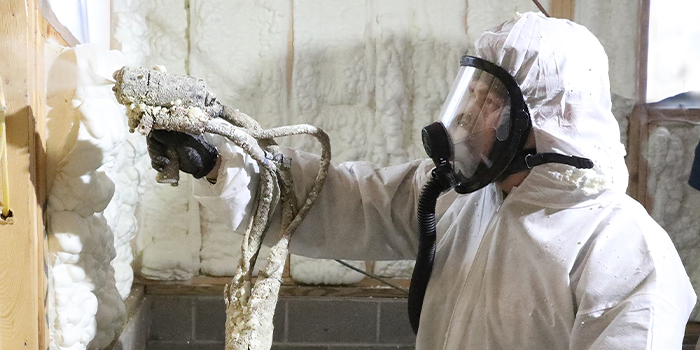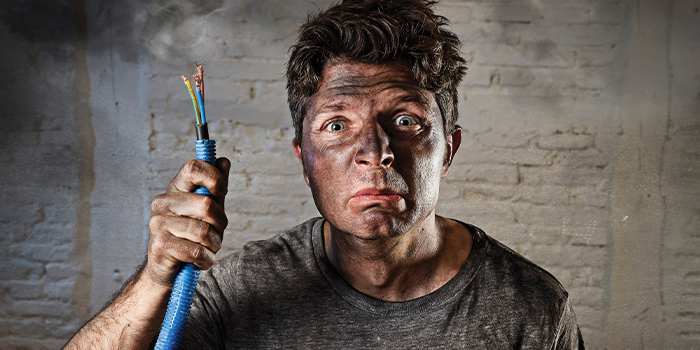Spray Foam in Extreme Climates


SPRAY FOAM MAGAZINE – In an era where the implications of climate change touch every corner of our planet, the importance of effective insulation cannot be overstated. Whether battling the relentless cold of Canada’s northern territories, or the destructive wrath of tornadoes and floods, proper insulation plays an instrumental role in protecting and sustaining structures. Spray foam insulation, with its versatility and adaptability, emerges as an exceptional solution for these extreme climatic challenges. This article delves into the unique application and performance of spray foam insulation across these disparate weather conditions.
Properties of Spray Foam Insulation
Spray foam insulation, composed of two parts, resin and ISO, is recognized for its unique ability to expand and fill gaps, cracks, and crevices, ensuring a tight seal. Unlike traditional insulating materials, spray foam offers a continuous barrier against air and moisture infiltration. This property alone sets it apart, as it can adapt to intricate architectural designs and unconventional structural layouts, making it particularly effective in challenging climates.
Furthermore, its high R-value, a measure of thermal resistance, means that it excels at minimizing heat transfer. Whether keeping the cold out during frigid northern winters or blocking intense sun rays during summer months, spray foam stands out in its ability to maintain stable indoor temperatures.
But its virtues extend beyond temperature regulation. Spray foam’s density and structural strength offer added benefits in areas prone to severe weather events like tornadoes and floods. Its ability to adhere to different materials strengthens building envelopes, reducing potential damage from high winds or water.
Extreme Cold: Northern Canada Housing
In the vast stretches of Northern Canada, temperatures can plunge to bone-chilling depths. For residents in these regions, maintaining a warm interior isn’t just about comfort—it’s a matter of survival. Traditional insulation methods often fall short, as the extreme cold tests the limits of their efficiency. However, spray foam insulation has proven to be a formidable ally against the northern chill.
One of the remarkable characteristics of spray foam insulation is its ability to prevent ‘thermal bridging.’ This phenomenon occurs when the cold outside easily penetrates a structure at its weakest insulated points, like wall studs or window frames. Spray foam, due to its expansive nature, can offer a continuous insulation layer, either inside or outside the structure, effectively breaking these thermal bridges and ensuring that warmth stays inside.
Take, for instance, the Îlot Rosemont building project faced the challenge of the Québec climate that necessitated insulation with a high thermal resistance. With winter temperatures often plummeting below -40°C, the architects turned to spray foam insulation. The result is a building that not only retains heat more effectively but also showcases a significant reduction in energy bills. Residents reported a stark difference in indoor comfort, and the bonus was a diminished carbon footprint due to reduced energy consumption.
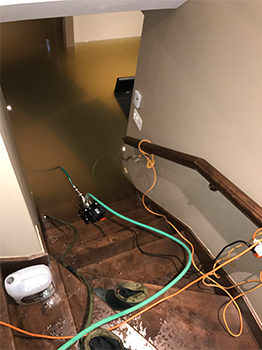
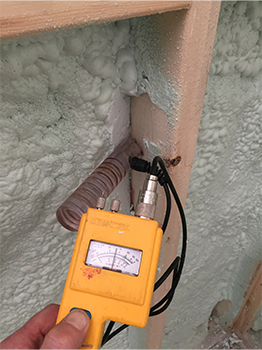
Battling Heat; Climate challenges in Canada
On the flip side of the thermal spectrum, Canada is heating up and this is posing a set of insulation challenges. While the nights may be coolish, daytime temperatures soar, and the relentless sun can turn buildings into ovens. It’s a climatic tug-of-war that demands robust insulation.
Spray foam insulation offers a dual advantage in such conditions. First, structures insulated with spray foam remain noticeably cooler, even during the peak of day. Secondly, the tight seal created by spray foam prevents the cooler night air from escaping, allowing residents to enjoy more stable and comfortable indoor temperatures round the clock.
In the last few years, the news has captured how nursing homes in Canada are unbearable for residents during days of extreme heat. While air conditioning needs to be running in these buildings, spray foam insulation can also provide a more comfortable living experience. Across Québec, a government-backed project is ongoing to provide seniors and adults living with disabilities rejuvenated living spaces, and an opportunity to vastly improve their quality of life. The hot climate was mitigated by the speed and ease of installation afforded by Heatlok Soya HFO, and residents will enjoy comfortable dwellings that eliminate air leaks and that keep the cool air in for decades to come.
Hurricanes: Fortifying Structures against Wind and Water
Hurricanes, with their devastating winds and torrential rains, present a multifaceted challenge to structures. Not only do buildings need to withstand the force of the wind, but they must also prevent water intrusion which can lead to mold growth and structural degradation. We just witnessed Hurricane Lee in Canada’s East Coast and the most severe hurricane to make landfall in Canada in the past 12 months was Fiona. It reached a wind speed of up to 194 km/h on September 23, 2022, near Halifax. According to the internationally accepted Saffir-Simpson classification, this corresponded to a category 3 hurricane. Spray foam insulation emerges as a crucial asset in these battles.
Firstly, the adhesive nature of spray foam strengthens the building envelope. When applied, spray foam binds with the surface, reinforcing walls and roofs against wind uplift and reducing the risk of damage from flying debris. This bond means that structures are less likely to suffer breaches during intense storms, helping maintain their structural integrity.
But the protection isn’t just against wind. Spray foam’s high resistance to water makes it an ideal choice in hurricane and tornado zones. Traditional insulation, once wet, can take a long time to dry out and often becomes a breeding ground for mold. In contrast, closed-cell spray foam has very low water absorption, ensuring that even after a storm, the interior remains dry, and the risk of mold growth is significantly reduced.
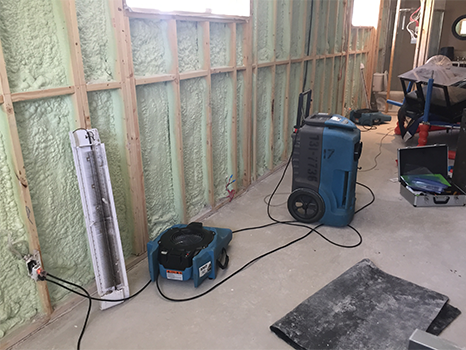
Flood Resilience: Keeping Water at Bay
Floods can be as devastating as hurricanes, if not more. The creeping rise of water seeping into homes can lead to long-term damage, ruining traditional insulation and compromising the structural safety of buildings. According to Public Safety Canada published in May of 2023, as sea levels rise and rainfall increases, flood damage to homes and buildings across Canada could increase fivefold in the next few decades and by a factor of 10 by the end of the century, with costs as high as $13.6 billion annually. Spray foam insulation offers a beacon of hope in such scenarios.
Closed-cell spray foam is buoyant and has a high resistance to water absorption. When regions are at risk of flooding, this type of insulation helps ensure that water doesn’t seep into walls and foundations, thus reducing potential damage. Moreover, even after exposure to floodwaters, spray foam maintains its insulating properties, unlike other materials that may need complete replacement.
Spring river floods are a common phenomenon; in fact, following the flood of a river in Québec, in the spring, Huntsman Building Solutions visited a residential home basement with four feet of contaminated water. The basement was insulated entirely with Heatlok Soya HFO, a closed-cell spray foam. The purpose of this visit was to check the condition of the foam insulation after five days [Photo 1] of immersion. The contaminated water was mixed with sewage and oil spillage.
Prior to site inspection, the walls had been washed and the basement had been cleaned with a pressure washer. Dehumidifiers and industrial fans had been in operation for five days [Photo 2]. To verify the effects of the flooding on the spray foam insulation, samples were taken on site for laboratory testing. Readings of the moisture content in the wood were made in several places [Photo 3]. Even after being submerged for several days, the spray foam insulation was dry and showed no signs of deterioration. Water absorption and mold growth were not present. With the assistance of dehumidifiers and fans, the uncovered wood dried. However, the wood studs embedded in the polyurethane were still moist but additional dehumidifying and ventilation days resolved that issue.
Scientific Data: a dive into research
The real-world applications of spray foam insulation are backed by a plethora of scientific research, ensuring that its benefits are not just anecdotal but empirically proven.
Structural Integrity: The structural benefits of spray foam insulation aren’t just builders’ tales. Scientific experiments, such as those conducted at the National Association of Home Builders, have shown that walls insulated with spray foam can withstand significantly higher wind loads. This is attributed to the adhesive nature of the foam, which binds and reinforces building materials, offering a higher degree of protection against external forces.
Water and Moisture Resistance: One of the chief advantages of closed-cell spray foam is its resistance to water and moisture. Lab tests have demonstrated that this type of foam is flood resistant (FEMA Class 5), making it an excellent barrier against flooding or moisture accumulation. Further, its hydrophobic properties mean it’s less likely to support mold growth, addressing a significant concern in both flood and hurricane-prone regions.
Cost-effectiveness: While the initial investment in spray foam insulation might be higher than traditional materials, its longevity and performance lead to long-term savings. In provinces like Ontario, where energy rates are relatively high, the adoption of spray foam insulation has been shown to result in substantial cost savings. For example, the Ontario Home Energy Savings program has indicated positive feedback on energy savings from households that have opted for spray foam insulation. Spray foam’s durability and efficiency result in long-term savings. Over a period of 20 to 30 years, the ROI (Return on Investment) can exceed 200-300%, considering the energy savings and low maintenance.
Conclusion
The world’s changing climatic patterns and the subsequent extremities in weather conditions have magnified the need for effective, reliable, and resilient insulation materials. Spray foam insulation stands tall amidst these challenges, providing unparalleled protection against the cold, heat, wind, and water. Its versatility, backed by scientific data, positions it as a frontrunner in insulation solutions for today’s world and the unpredictable future that lies ahead.
Jean-François Lupien is the Global Director of Product Management with Huntsman Building Solutions.
*Spray Foam Magazine does not take editorial positions on particular issues; individual contributions to the magazine express the opinions of discrete authors unless explicitly labeled or otherwise stated. The inclusion of a particular piece in the magazine does not mean that individual staff members or editors concur with the editorial positions represented therein.
For use by SprayFoamMagazine.com & Spray Foam Magazine
Disqus website name not provided.






